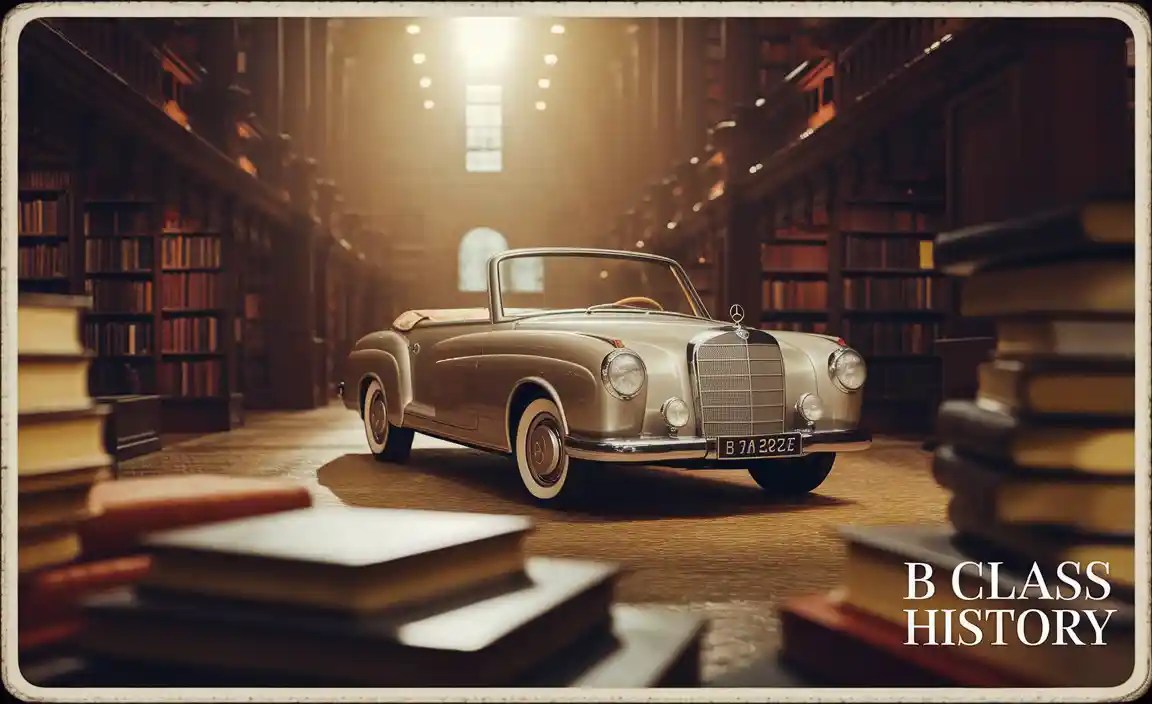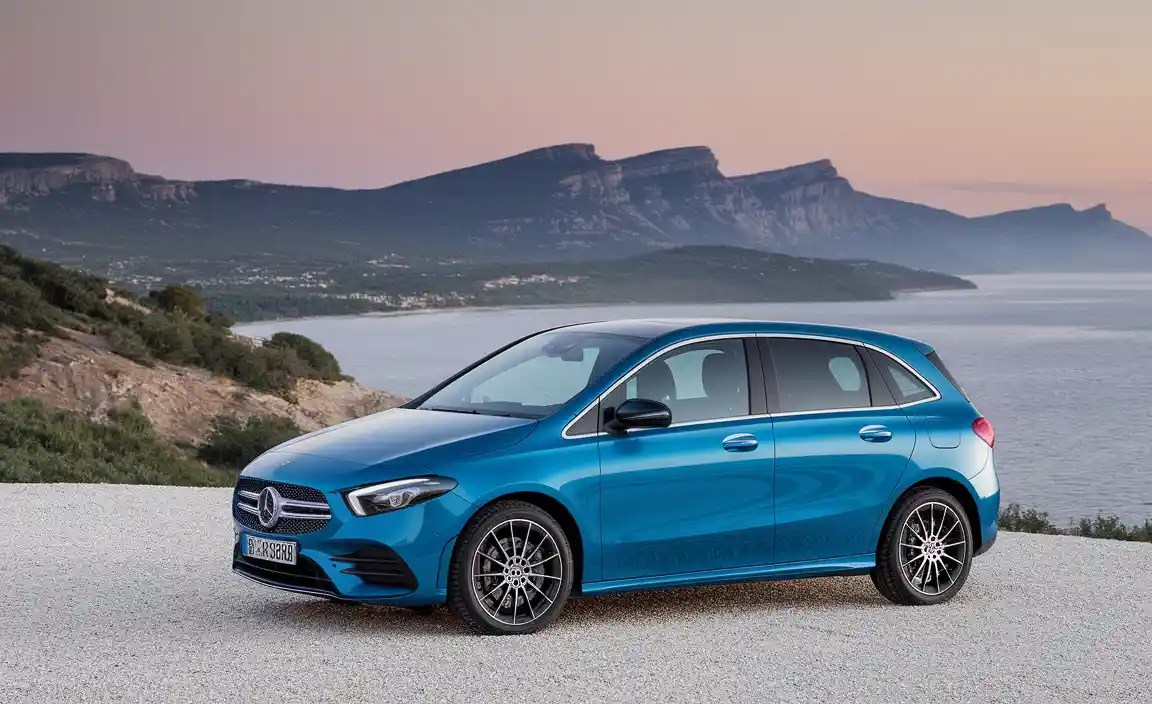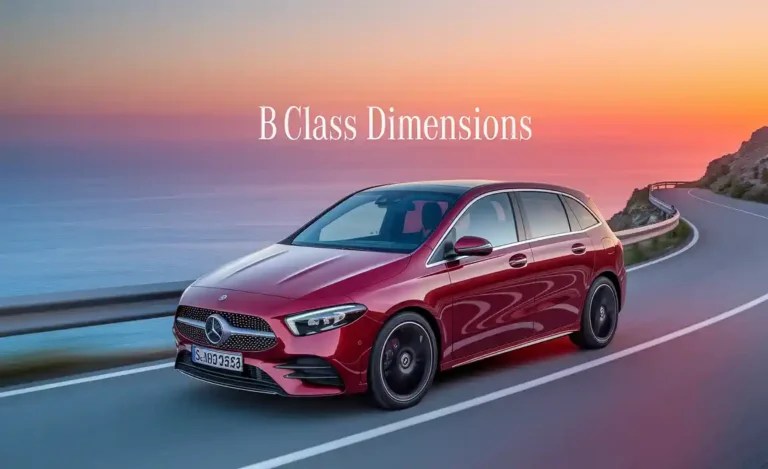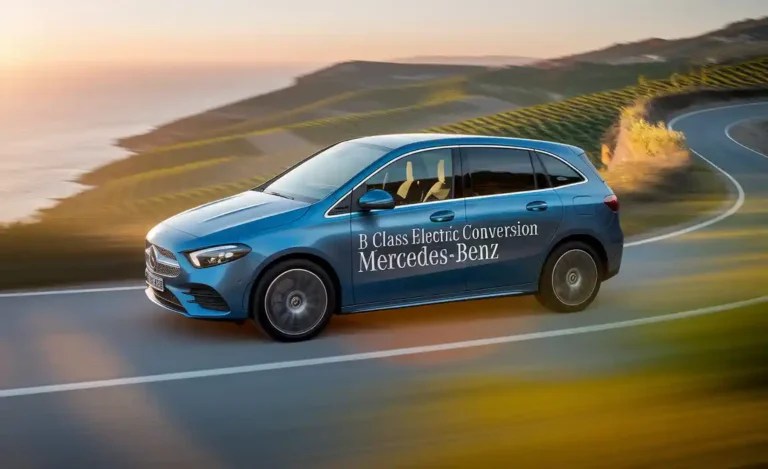B Class History: Legendary & Essential
The Mercedes-Benz B-Class is a versatile compact car revered for its spacious interior, practical design, and premium feel. It seamlessly blends everyday utility with Mercedes-Benz luxury, making it an essential choice for those seeking comfort, safety, and sophisticated style in a compact package.

Welcome to MercedesBlue! If you’ve ever wondered about the story behind Mercedes-Benz’s innovative compact offerings, you’re in the right place. The B-Class represents a pivotal chapter in Mercedes-Benz’s history, showcasing a clever approach to maximizing space and utility within a smaller footprint. For many, understanding the lineage and unique advantages of a model like the B-Class can be a journey of discovery. It’s about appreciating how a car can be both practical for daily life and undeniably a Mercedes-Benz. We’re going to explore its evolution, its key features, and why it remains a beloved, essential vehicle for so many around the globe.
The Genesis of the B-Class: A New Era for Mercedes-Benz
The Mercedes-Benz B-Class emerged onto the automotive scene with a distinct purpose: to offer the premium quality, safety, and innovation synonymous with the brand, but in a more accessible and practical package. Launched in 2005 for the 2006 model year, the first generation (W245) was a bold move for Mercedes-Benz, a company long associated with executive sedans and robust SUVs. The company recognized a growing demand for compact, versatile vehicles that didn’t compromise on passenger comfort or cargo space, a niche the B-Class was designed to fill perfectly. This innovative design, often referred to as a “compact sports tourer,” prioritized interior volume and a higher driving position, setting it apart from traditional hatchbacks.

This “sandwich concept,” where the powertrain components were located beneath the floor between the front and rear axles, was a stroke of genius. It allowed for a remarkably spacious cabin and an exceptionally flat floor, maximizing passenger legroom and creating a flexible cargo area. This engineering marvel was a testament to Mercedes-Benz’s commitment to intelligent design, proving that compact could still mean capacious and comfortable. It was a calculated step to broaden the brand’s appeal to a new demographic seeking a premium, yet eminently practical, Mercedes-Benz.
First Generation B-Class (W245): The Pioneer (2005-2011)
The original B-Class, codenamed W245, arrived as Mercedes-Benz’s answer to the evolving needs of urban dwellers and families who desired a premium vehicle with enhanced practicality. Its defining characteristic was the innovative “sandwich floor” design. This ingenious layout placed the engine and transmission beneath the passenger cabin floor, in a layered, or “sandwich,” configuration. The benefits were immediate and significant:
- Enhanced Safety: In a frontal impact, the engine and transmission would slide underneath the passenger cell, providing an exceptional crumple zone and protecting occupants. This passive safety feature was a hallmark of Mercedes-Benz engineering.
- Maximized Interior Space: The flat floor and upright seating position created an airy and surprisingly roomy cabin, particularly for rear passengers.
- Versatile Cargo Area: The generous luggage capacity, which could be further expanded by folding the rear seats, made the B-Class a capable companion for shopping trips, weekend getaways, or hauling larger items.
- Higher Driving Position: The elevated seating offered a commanding view of the road, enhancing driver confidence and enjoyment, akin to a larger vehicle.
Under the hood, the W245 B-Class offered a range of efficient petrol and diesel engines, catering to various driving needs and fuel economy preferences. Later in its lifecycle, it also introduced the B 170 NGT (Natural Gas Technology) model, showcasing Mercedes-Benz’s early explorations into alternative fuels. While it wasn’t a sports car, the B-Class provided a comfortable and refined driving experience, embodying the brand’s commitment to quality materials and solid construction, even in its compact segment.
Second Generation B-Class (W246): Evolution and Refinement (2011-2019)
The second-generation B-Class (W246), launched in 2011, represented a significant evolution of the original concept. While retaining the core principles of spaciousness and practicality, Mercedes-Benz refined the design, enhanced the technology, and improved the driving dynamics. The distinctive “sandwich concept” was subtly re-engineered to optimize the vehicle’s center of gravity, leading to a more engaging and car-like driving experience. The exterior design became sleeker and more aerodynamic, giving it a more modern and premium appeal.
Key Advancements in the W246 B-Class:
- Improved Aerodynamics: The sleeker lines not only looked better but also contributed to reduced wind noise and improved fuel efficiency.
- More Dynamic Handling: Engineers focused on enhancing the chassis and suspension, resulting in a more agile and responsive ride, bringing it closer to the feel of a C-Class or A-Class.
- Advanced Technology Integration: This generation saw the introduction of Mercedes-Benz’s latest infotainment systems, including the COMAND Online system, and a host of advanced driver-assistance systems. Features like COLLISION PREVENTION ASSIST (a basic autonomous emergency braking system) became available, underscoring Mercedes-Benz’s dedication to safety.
- Expanded Powertrain Options: The engine lineup was updated with more efficient turbocharged petrol engines (M270 series) and updated diesel engines (OM651 series).
- Electric Variant: A significant development was the introduction of the B 250 e (later B 250e), an all-electric model, marking a serious commitment by Mercedes-Benz to electric mobility in the compact segment. This demonstrated foresight, aligning with the increasing global focus on sustainability.
The W246 was a critical success, praised for its ability to blend the practicality of an MPV with the premium feel and advanced technology expected of a Mercedes-Benz. It successfully broadened the brand’s appeal, attracting younger buyers and those seeking a versatile luxury vehicle for urban and suburban life.
Third Generation B-Class (W247): The Modern Sports Tourer (2019-Present)
The third and current generation B-Class (W247), introduced in 2019, further cemented its position as a sophisticated and versatile compact car. While the “sports tourer” designation remains, the W247 leans more towards a premium compact hatchback with an elevated stance and impressive interior space. Mercedes-Benz continued to refine the design, making it sleeker and more elegant, while significantly upgrading the technology and performance.

Key Features of the Current B-Class (W247):
- MBUX Infotainment System: This generation fully embraced the revolutionary Mercedes-Benz User Experience (MBUX) system. MBUX offers intuitive voice control (“Hey Mercedes”), a stunning dual-screen digital cockpit, and advanced connectivity features.
- Enhanced Safety Suite: Building on previous generations, the W247 boasts an even more comprehensive array of active and passive safety systems, including adaptive cruise control, active lane-keeping assist, blind-spot monitoring, and a highly robust passive safety structure.
- Efficient and Powerful Engines: A range of modern, fuel-efficient engines are available, including powerful petrol and diesel options, along with plug-in hybrid (PHEV) variants for those seeking electrified performance and reduced emissions. The PHEV models, like the B 250 e, offer significant electric-only range, making them ideal for daily commutes.
- Refined Driving Dynamics: The W247 offers a balanced driving experience, with comfortable suspension for everyday journeys and engaging handling when the road opens up.
- Focus on Sustainability: With the increasing emphasis on eco-friendly transportation, the availability of plug-in hybrid models underscores Mercedes-Benz’s commitment to reducing its environmental impact.
The W247 B-Class successfully merges the practicality of its predecessors with the latest advancements in automotive technology and design. It’s a car that feels premium, safe, and highly connected, making it an exceptionally well-rounded choice for discerning buyers in the compact luxury segment.
Why the B-Class is Essential: Practicality Meets Prestige
The enduring appeal and essential nature of the Mercedes-Benz B-Class stem from its unique ability to bridge the gap between practicality and premium luxury. It’s not just another compact car; it’s a meticulously engineered Mercedes-Benz designed for drivers who demand more from their everyday vehicle.
The Pillars of B-Class Essentiality:
- Unparalleled Interior Space for its Class: The innovative packaging, especially the “sandwich concept” in earlier generations and clever interior design in current models, consistently delivers exceptional passenger room and cargo flexibility. This makes it ideal for families, active individuals, or anyone who needs to carry more than just themselves.
- Exceptional Safety Standards: As with all Mercedes-Benz vehicles, safety is paramount. The B-Class benefits from the brand’s industry-leading safety innovations, from its robust structural integrity and advanced airbag systems to its comprehensive suite of driver-assistance technologies.
- The Mercedes-Benz Driving Experience: Even in its compact form, the B-Class offers the refined ride quality, precise handling, and quiet cabin that Mercedes-Benz owners have come to expect. It feels substantial and comfortable, making long journeys as enjoyable as short commutes.
- Cutting-Edge Technology: From the sophisticated MBUX infotainment system to advanced driver aids and efficient powertrain options (including plug-in hybrids), the B-Class is always at the forefront of automotive technology, offering convenience, connectivity, and a glimpse into the future of driving.
- Brand Prestige and Quality: Owning a B-Class means owning a Mercedes-Benz. This comes with the assurance of superior build quality, durable materials, and the peace of mind that comes from driving a vehicle from a marque renowned for its engineering excellence for over a century.
For those who might look at larger sedans or SUVs but don’t need the excessive size or fuel consumption, the B-Class presents an intelligent, highly practical, and deeply satisfying alternative. It embodies Mercedes-Benz’s commitment to creating vehicles that are not only desirable but also genuinely useful for their owners’ lives.
Key B-Class Generations at a Glance
To help visualize the evolution, here’s a quick comparison of the main B-Class generations:

| Generation | Codename | Years | Key Innovations/Characteristics |
|---|---|---|---|
| First | W245 | 2005–2011 | “Sandwich concept”, high safety, flexible cargo, elevated driving position. |
| Second | W246 | 2011–2019 | Sleeker design, improved dynamics, advanced tech (MBUX precursor), electric variant (B 250 e). |
| Third | W247 | 2019–Present | MBUX infotainment, comprehensive safety suite, plug-in hybrid options, modern hatchback design. |
Understanding B-Class Engines and Drivetrains
Throughout its history, the B-Class has been offered with a diverse range of powertrains, each designed to balance performance, efficiency, and the premium Mercedes-Benz feel. The choice of engines has significantly evolved to meet changing emissions standards and consumer demands.
Petrol Engines:
Early B-Class models featured naturally aspirated four-cylinder engines. As automotive technology advanced, Mercedes-Benz transitioned to turbocharged direct-injection petrol engines. These modern powerplants offer a better balance of power and fuel economy. For instance, current models often feature the M270 and M274 series engines, known for their responsive performance and efficiency.
Diesel Engines:
Diesel engines have always been a strong suit for Mercedes-Benz, and the B-Class has benefited from this expertise. The OM640 and later OM651 diesel engines provided excellent torque and remarkable fuel efficiency, making the B-Class an economical choice for long-distance driving. Current diesel options continue this tradition with advanced common-rail technology and particulate filters for cleaner emissions.
Alternative Fuels and Electrification:
Mercedes-Benz has also been forward-thinking with alternative fuel options. The first generation saw the B 170 NGT running on natural gas. The second generation introduced the all-electric B 250 e, a significant step towards electrification. The current generation continues this trend with highly efficient plug-in hybrid (PHEV) variants, offering substantial electric-only driving range for urban commutes, coupled with the flexibility of a petrol engine for longer trips. These PHEV models are crucial for reducing running costs and environmental impact.
Drivetrain Configurations:
Most B-Class models traditionally feature front-wheel drive, which is ideal for maximizing interior space and efficiency in a compact vehicle. However, depending on the market and specific model, some variants may offer all-wheel drive (4MATIC) for enhanced traction and stability in challenging conditions. Transmission options have evolved from manual gearboxes in early models to sophisticated 7-speed and 8-speed dual-clutch automatic transmissions (7G-DCT, 8G-DCT) in newer generations, providing smooth and rapid gear changes.
For detailed specifications on engine options available in your region, it’s always best to consult the official Mercedes-Benz configurator or a local dealership, as offerings can vary significantly.
Maintaining Your B-Class: Essential Tips
Like any luxury vehicle, routine maintenance is key to ensuring your Mercedes-Benz B-Class performs optimally and retains its value. Adhering to the manufacturer’s recommended service schedule is the most important step. You can typically find this information in your owner’s manual.
Key Maintenance Intervals and Checks:
- Oil Changes: Mercedes-Benz vehicles often use synthetic oil. The interval can vary based on driving conditions, but usually falls between 10,000 to 15,000 miles (15,000 to 25,000 km). Always use the specific oil type recommended by Mercedes-Benz.
- Brake System: Regular checks of brake pads, rotors, and fluid are crucial for safety. Listen for any unusual noises and have the system inspected during scheduled services.
- Tire Rotation and Alignment: To ensure even tire wear and optimal handling, have your tires rotated every 5,000 to 7,500 miles (8,000 to 12,000 km) and check wheel alignment periodically, especially if you notice uneven wear or the car pulling to one side.
- Filters: Replace the engine air filter and cabin air filter as recommended. This ensures engine efficiency and clean cabin air.
- Fluid Levels: Regularly check coolant, power steering fluid (if applicable), and windshield washer fluid levels.
For tasks beyond basic checks, such as complex engine diagnostics or transmission servicing, it’s often best to rely on qualified Mercedes-Benz technicians or reputable independent Mercedes-Benz specialists. They have the specialized tools and knowledge to properly service your vehicle. For example, the advanced diagnostic systems used by Mercedes-Benz, like the XENTRY/DAS system, require specialized equipment to interpret and address complex fault codes. You can learn more about advanced automotive diagnostics from resources like the Automotive Service Association (ASA), which often highlights the importance of using qualified technicians. TBC consumer resources often provide valuable advice on choosing auto repair shops.
Frequently Asked Questions About the B-Class
What is the main advantage of the Mercedes-Benz B-Class?
The primary advantage of the B-Class is its exceptional interior space and practicality within a compact footprint, combined with the premium safety, comfort, and luxury expected of a Mercedes-Benz. Its clever design maximizes passenger and cargo room.
Is the B-Class a hatchback or an MPV?
The B-Class is often described as a “compact sports tourer” or premium compact hatchback. It blends the elevated driving position and spaciousness often associated with MPVs (Multi-Purpose Vehicles) with the sleeker styling and driving dynamics of a hatchback.
Are B-Class models reliable?
Mercedes-Benz vehicles, including the B-Class, are generally built to high standards of quality and reliability. However, like any car, they require regular, scheduled maintenance to ensure longevity and optimal performance. Following the manufacturer’s service plan is key.
What does the “sandwich concept” mean for the B-Class?
The “sandwich concept,” featured prominently in earlier generations (W245 and W246), refers to a design where the engine, transmission, and other drivetrain components are mounted beneath the passenger cabin floor in a layered configuration. This allowed for maximum interior space and improved safety in frontal impacts.
Are there electric or hybrid versions of the B-Class available?
Yes, Mercedes-Benz has offered electric variants, such as the B 250 e, and the current generation includes highly efficient plug-in hybrid (PHEV) models. These offer reduced emissions and excellent fuel economy.






